第4回 オーストリア、ドイツ、オランダを走り抜ける旅の最終章
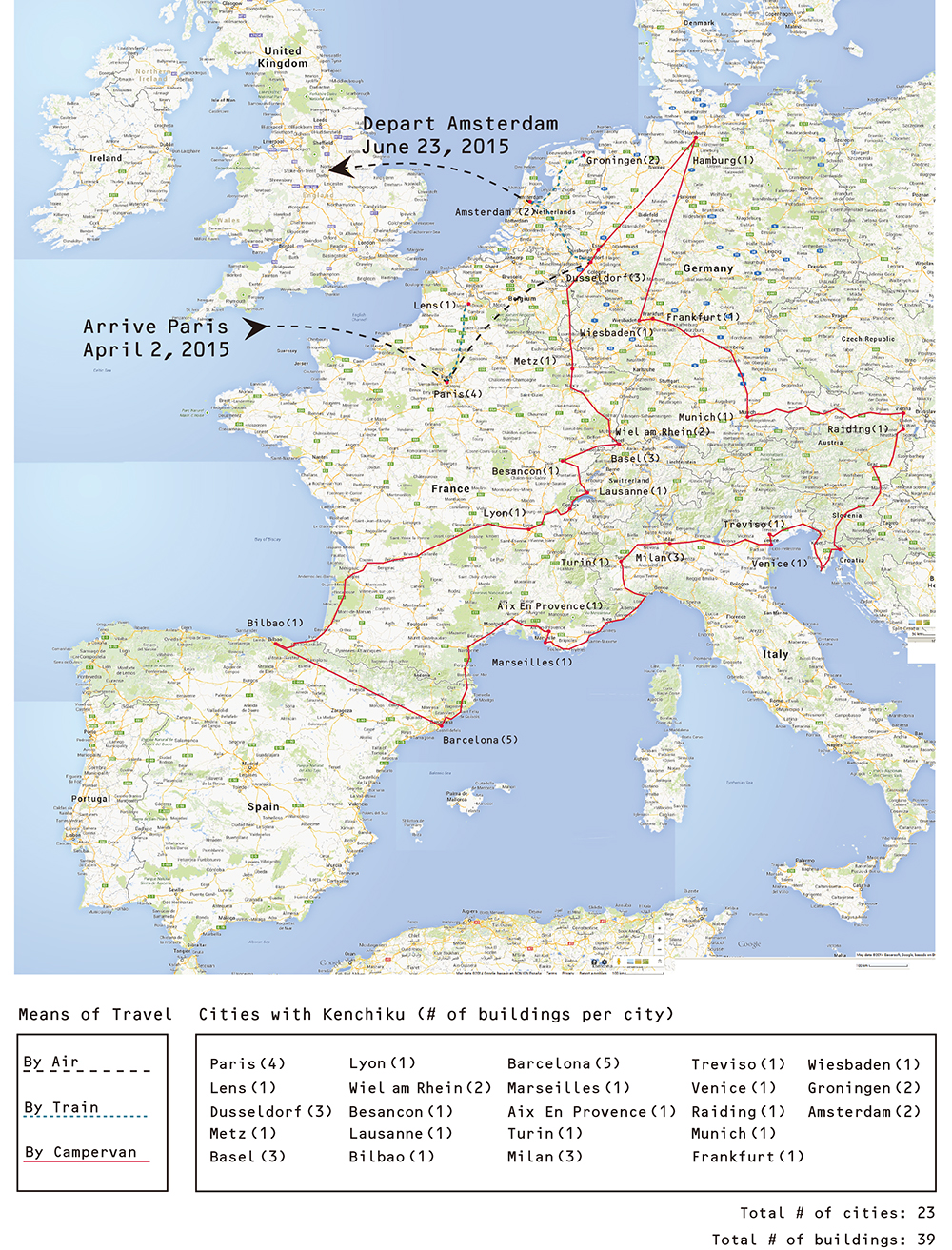
旅行ルート/Itinerary.〈クリックで拡大〉
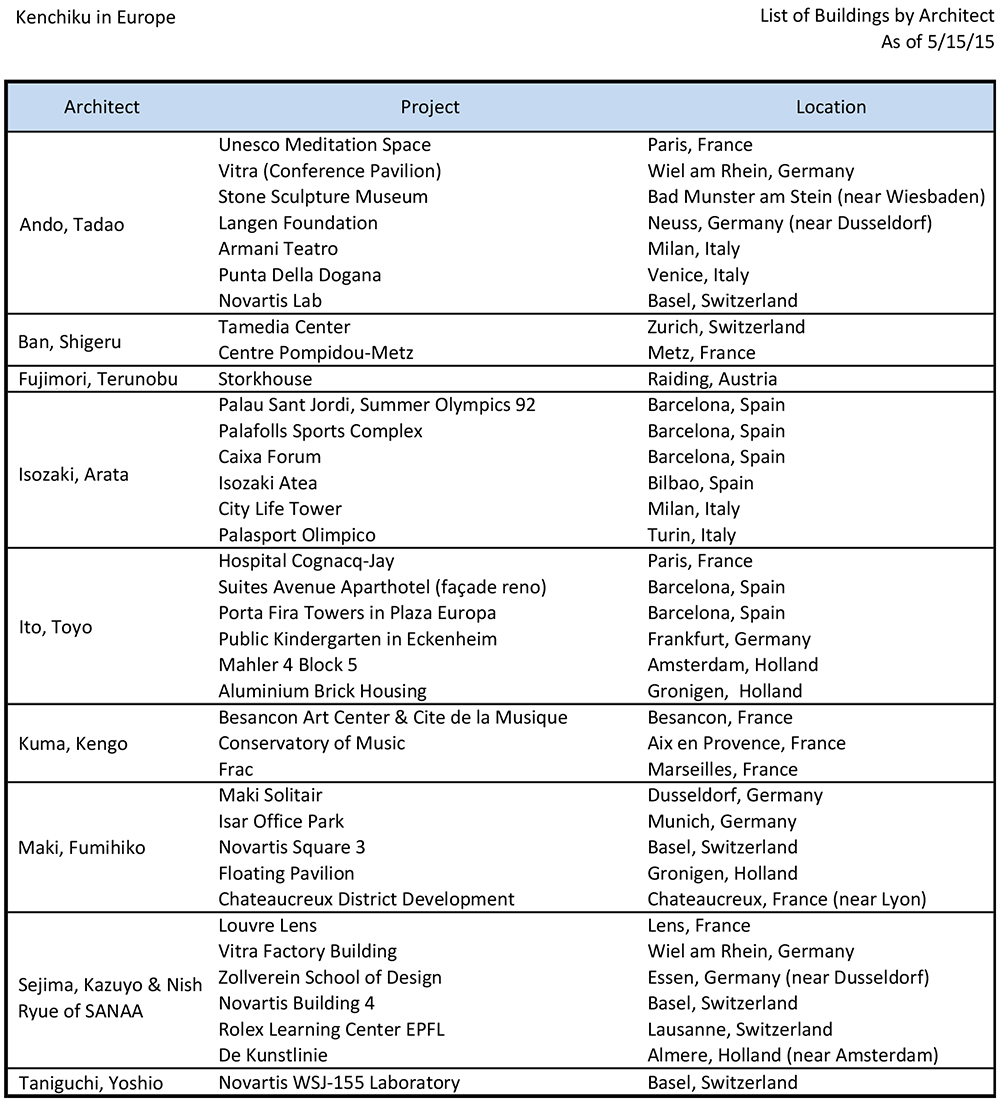
建築家、建築作品リスト/List of Architects and Architecture.〈クリックで拡大〉
オーストリアもご多聞に漏れない。どんなに小さな農村であってもその土地特有のチーズ、ビール、ワインだけでなく、専ら"林業に関した"新手の技術の導入など観光誘致する可能性があるものはなんでも積極的に取り入れ、来訪者の呼び込みに躍起だ。例えば人口1,000人程度のクルンバッハという村は、世界的に著名な建築家7名を選び、独創的なデザインのバス停を7つ建設した。東部のはずれにある人口2万7,000人のグッシング市は、独自に木質チップバイオマス発電装置を設置し、エネルギー的に独立したことを観光誘致の売り文句にしている(実際現地案内は英語対応可能とある)。発電だけでなく省エネルギー効果が大きいパッシブ住宅の人口一人当たりの戸数は世界一高いこともあり★1、さまざまな集落でもパッシブハウスを巡るツアーが頻繁に行なわれている。
藤森照信《鸛庵(こうのとりあん)》(オーストリア、ライディング、2014)
この地域活性化の大きなうねりのなかで、私たちは東部の小村ライディングにたどり着いた。この地は19世紀の作曲家フランツ・リストの生誕地であることでよく知られている。大都市であるウィーンへも車で1時間といった立地も特徴的だ。東京が活動拠点のオーストリア人ライター、写真家、フィルムメーカーであるローランド・ハーゲンバーグが立ち上げた「ライディング・プロジェクト」は日本人建築家に小規模の実験住宅を10棟設計させることで日本とオーストリア間の文化交流促進を目的としたものだ。そのなかで地域の自然素材を多用する建築家、建築史家である藤森照信氏設計による《鸛庵》が今回の"ケンチク"である。このハウスは10棟のプロジェクトの第1棟めとして2013年に竣工した。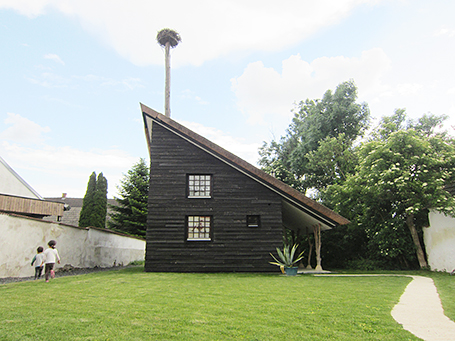
- 藤森照信《鸛庵(こうのとりあん)》は、10棟のなかで最初に完成した作品/The first of ten houses designed by Japanese architects to be realized in Raiding, Austria: Storkhouse by Terunobu Fujimori.
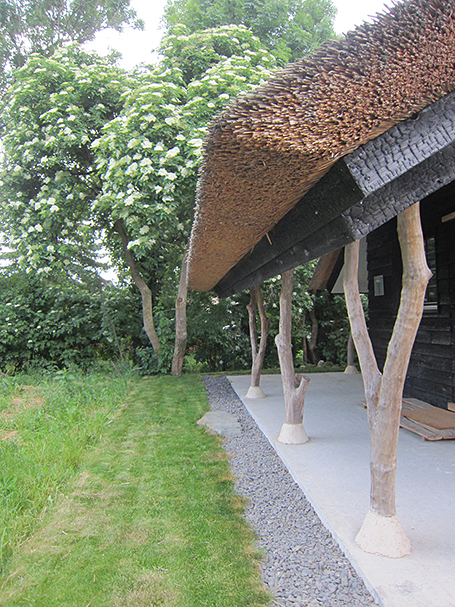
- 伝統的な藁葺きでできている屋根/Fujimori employed traditional thatch technique for the roof of Storkhouse.
自然素材であふれ、奇妙なツリーハウスなどのデザインで有名な藤森氏は、ミニマリズムや白色で統一された──現代的"禅"とでも言うべきか──スタイルを発信するほかの日本人建築家とは明らかに一線を画している。ときとしてスペインのアントニオ・ガウディや地元ウィーンの建築家であり画家であったフンデルトヴァッサーと比較してみると、藤森氏の《鸛庵》はオーストリアの背景に見事に調和すると感じられる。表面を焼いて黒く炭化した板張りの外壁と厚く積み重ねられた茅葺屋根のおかげで、《鸛庵》は雨露や腐食から守られている。今回の旅行前に藤森氏にインタヴューした際には「使用する木を選んで集落の人々数人で切り倒した。そしたら、いつの間にやら興味津々なのか笑顔にあふれた人々が集落中から集まってきてきました。そのときね、あーこのプロジェクトは成功するなと感じました」と建設時のエピソードを語ってくれた。藤森氏は「日本人ではないクライアントたちは日本からやってきた建築家である藤森氏に何か特別な期待があったと思いますか?」という問いかけに対して少し間を置いて「僕には特段わからなかった」と答えるにとどまった。藤森氏は設計に先駆け敷地周辺の生態系を調査しており、夏の季節にコウノトリがアフリカからこの地域に渡って来て営巣することを確認したそうだ。そこから営巣のための台をタワー上部に設置することで、彼なりの"ケンチク"の土着性を示そうとしたとインタヴュー時に伺った。実際毎年夏になるとタワー上部にコウノトリが営巣しているそうである。《鸛庵》は一般公開されており、宿泊も可能である。ライディング・プロジェクト第2弾は原広司氏による《ハラ・ハウス》。目下建設中とのこと。
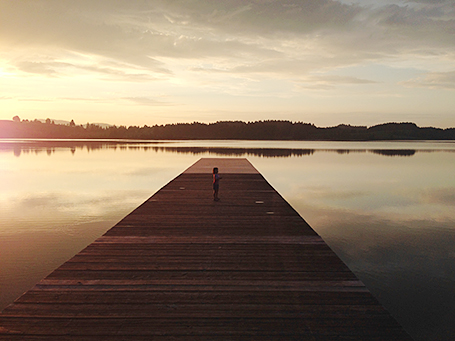
- フォルクスワーゲンのキャンパーバンでキャンプをする最後の晩。太陽が沈んでゆく南バイエルン、Bannwaldseeの風景に酔いしれる。/Our last night camping in the VW we were treated to this scenery, sun setting over Campingplatz Bannwaldsee in southern Bavaria.
ザ・アンドウ・ケンチク──《ランゲン財団美術館》(ドイツ、デュッセルドルフ近郊、ノイス、2004)
都市の活気をウィーンとミュンヘンで数日ずつ楽しんだ後、私たちのキャンピングカーはシンデレラ城のモデルとなったお城を目指してロマンチック街道をひたすら走った(「ロマンチック街道」の呼称はなぜかドイツ語と日本語だけで、道沿いの標識に示されていた)。ドイツ中部のノイスという町の近郊に元NATO軍事基地であった広大な敷地に広がるインゼル・ホンブロイッヒ美術館に立ち寄った。さまざまな建築家や芸術家によってデザインされたパヴィリオンが歳月をかけて建てられている。安藤忠雄氏によるランゲン財団美術館もそのひとつに当たる。約1300㎡のガラスボックスと安藤氏独特のコンクリート壁からなる美術館であるが、主にマリアン・ランゲン婦人が所有していた近代美術作品を所蔵している。美術館竣工時期は2004年であるが、安藤氏はプロジェクト開発担当者から1994年に委託をされ敷地検証に関わっていている。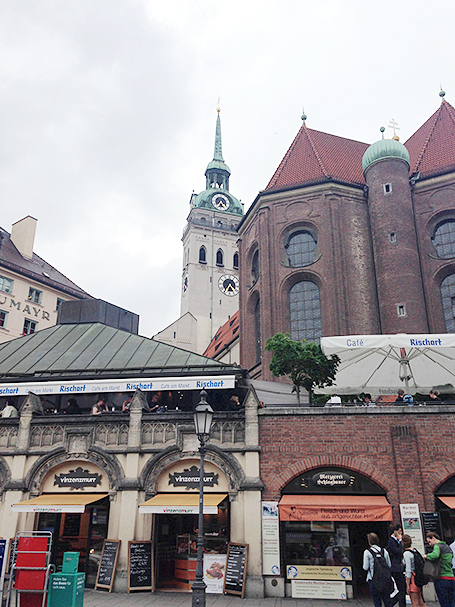
- ミュンヘンの厚みのある歴史が、歴史的建造物や商店の店頭に表われている。/Munich's rich history is reflected in the layering of its historical buildings and storefronts.
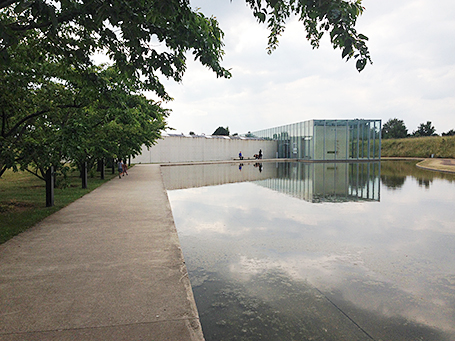
- 安藤忠雄《ランゲン財団美術館》/The Langen Foundation by Tadao Ando in Neuss, Germany.
徒歩で訪問することを前提にアレンジされた安藤氏独特のドラマティックなエントリー動線は、擁壁に一箇所だけある開口部をくぐってプロムナードを進むと、メイン・エントランスのあるガラスボックスを囲むように湖面が広がり、湖面を斜めに横切るようにしてエントランス向かっていく。しかしながら私たちは美術館に直接キャンピングカーで、美術館の奥手にある駐車場に向かっため。この過程で入口のプロムナードや湖面が見えてしまった。手品はばれてしまったが、それでも彼のエントリー動線はすばらしい。残念なのは、コンクリートの現状を見たらおそらく安藤氏が嘆くだろうと思ったこと。コケに覆われ、雨水の影響かコンクリ壁の上部に百華のようなシミが結構な割合で見受けられた。メイン・エントランスのガラスボックスのガラスにも割れがあり、少なくとも数カ月は放置されているようであった。今回の旅で安藤氏による"ケンチク"を訪れるたびに、建築物の維持管理が行き届いて感心していたが、この《ランゲン財団美術館》は特別なのか? もう少しメインテナンスしてもよいと思うが。
孤高の《マキ・ソリティア》(ドイツ、デュッセルドルフ、2001)
9週間"我が家"と呼んできたVWキャンピングカーにお別れをする時期がやってきた。ビジネス街と観光地が入り混じったような独特の活気にあふれるデュッセルドルフにやっと戻ってきたのだ。在デュッセルドルフ日本国総領事館によると、ドイツ生まれのいわゆる日系ドイツ人や永住者を含んだデュッセルドルフ在住日本人は約1万1,000人にもなるそうだ。1950年から約500もの日系企業が居を構えてきたそうだ。例えば、大手ゼネコンの竹中工務店はこの地にヨーロッパ本部を置いて40年にもなる。否応なしに興味がわいて市中を巡り歩いたところ、日本語の本屋、旅行会社、食料品店、そして雑貨店までてんこ盛りである。面白かったのはレストランやパブで地元の名物料理"シュニッツェル"と並んで日本の"トンカツ"があったり、地元のキャベツの漬物である"ザワークラウト"と並んで"ツケモノ"が並んでいたり、そして極めつけは地ビールである"ヘーフェヴァイツェン"と"キリン一番搾り"の生ビールが一緒に楽しめたりすることだ。これほど日本食が豊かに揃っている町はデュッセルドルフがこの旅では初めてではないか?デュッセルドルフ市内の旧ライン川沿いに開発中のメディア・ハーバー地区は、かつてほとんど見捨てられた倉庫街であったが、広告業、芸術、メディアなどのクリエイティヴ産業の中心地へと華麗な変身を遂げた。デュッセルドルフ市のホームページによると"この再開発は建築デザインに厳しい規制をかけることを目的としていない。かえってさまざまな強烈な個性を主張しあう建築デザインの多様性が地域の個性的で創造的な雰囲気をかもし出すことに貢献している"と説明している。この地区のほとんどすべての建築物は世界的に著名な建築家によりデザインされており、例えばフランク・ゲーリー、デイビッド・チッパーフィールド、スティーブン・ホール、ヘルムート・ヤンはその一例。視察時は建設中であった巨大な複合施設はレンゾ・ピアノによるものだ。これらの建築家にはそれぞれが独創的に開発に寄与できるようにデザインおいて相当な自由度が与えられている。それらのなかで、槇文彦氏がデザインした8階建ての《マキ・ソリティア》(「孤高」の意)と地元で呼ばれるオフィスビルは、メディア・ハーバー再開発の第1棟めとして2001年に竣工。槇氏はインタヴューの際に「《代官山ヒルサイドテラス》に感銘を受けた民間開発業者から直接依頼があった」とコメントがあったが、実際《ヒルサイドテラス》で見受けられるようなアルミ製のクラディングや水平ルーバーなどがメディア・ハーバー再開発の今後の方向性定義を示唆するかに見受けられた。しかしながら《マキ・ソリティア》の思慮深い構成は、自己のデザイン意図の主張が強くお互いに釣り合わない複数の後続した建築物のなかに埋没してしまったように感じられた。
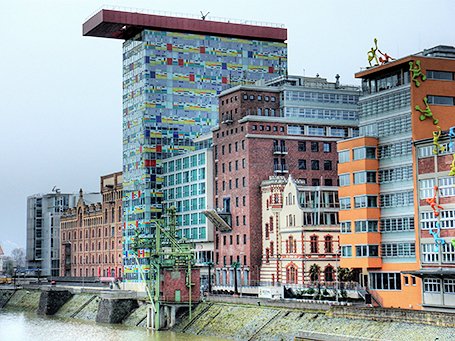
- 槇文彦《マキ・ソリティア》(左奥)はメディア・ハーバー地区の建築群のなかに埋もれて見える。/Munich's rich history is reflected in the layering of its historical buildings and storefronts.
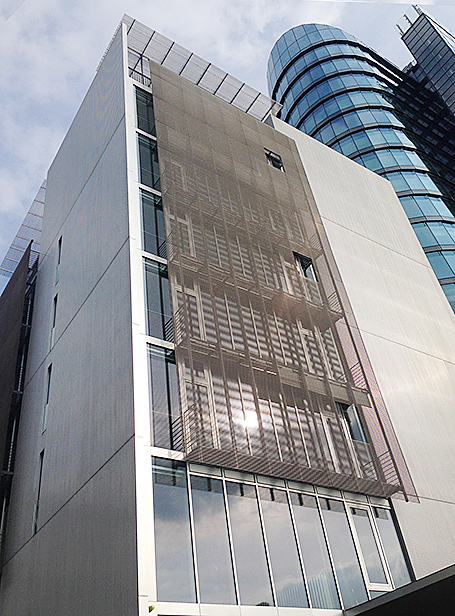
- 旅路でたくさんみかけたような建築だが、「ソリティア=孤高」は建築家・槇に与えられた尊称だ。/Maki-Solitaire, like several other buildings we found on our journey, is named for its architect Fumihiko Maki.
h3>伊東豊雄《イトウ・タワー》(オランダ、アムステルダム、2005) 気の向くままに移動できたキャンピングカーにお別れをして、鉄道での移動に移るのはまさに後ろ髪を引かれる気分であった。鉄道での目的地はこの旅の最終目的地であるアムステルダム。鉄道での移動は論理的には容易なはずだが、スーツケース2つ、その他大きな荷物4つにベビーカーに乗った幼児2人を伴う鉄道での移動は甘くはなかった。とにもかくにも高速鉄道でアムステルダム中央駅まで到着し、ワゴンタクシーに乗車。なんとか無事に滞在先であるアパートに転がり込んだ。これからの1週間を過ごすアパートはアムステルダムのなかでもヒップで洗練された若者があふれる街区に位置している。まさに街のど真ん中であり、どこに行くにも徒歩ですませることができるのには助かった。街を縦横無尽に張り巡る運河、歩道に並ぶカフェのテーブル、自転車で走り回る人々であふれる道路、そして歳月を感じさせるレンガ造りのファサードなどの視覚的な豊かさは、心に焼きとめられないほどだ。
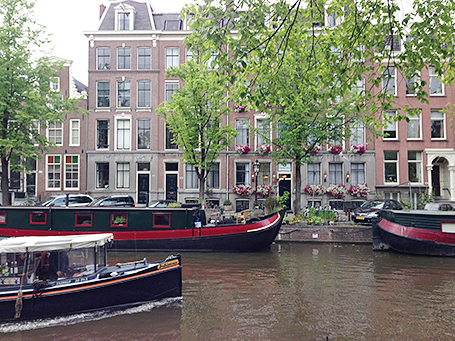
- 最後の目的地アムステルダムに着いたとき、これ以上の美しさは考えようがなかった。/By the time we reached Amsterdam, our final destination, we almost couldn't absorb any more beauty.
デュッセルドルフ市内のメディア・ハーバー地区と同様に、アムステルダムでも"ズイダス"(オランダ語で「南の軸」)と呼ばれる新興ビジネス街が開発されている。パリの"ラ・デファンス"やロンドンの"カナリー・ワーフ"の都市再開発と同様にズイダスも多国籍大企業やクリエイティヴ産業の誘致に力を入れており、まさにメディア・ハーバーと同様に再開発地区内の全建築物はポストモダニズム、ハイテク、スーパーダッチ派のいずれを問わず皆世界的に著名な建築家による作品となっている。ラファエル・ヴィニオリ、ノーマン・フォスター、マイケル・グレイブス、SOMなどはそれらの一例である。
26階建ての高層オフィスタワー"イトウ・トレン"("トレン"はオランダ語で「タワー」の意味)は2005年に竣工。建築家はその名のとおり伊東豊雄氏。オフィスタワーの案内パンフレットには伊東氏のデザインコンセプトが説明されており、"日本的なエレガンスさ"がデザインの趣旨とのこと。ソリッドとボイドからなる透明感豊かなガラスパネルは白地にコーティングされたアルミパネルと完全に一体化している。全体的な建築物のマスは鋭角の鋭さを表現した階段構成であり、建物の内部まで日光が届くように大きなボイドが建物の奥まで続いている。建物高さ約100m、26階建てで床面積が40,000㎡ということだから、このズイダス地区内では飛びぬけて大規模なビルとなっている。
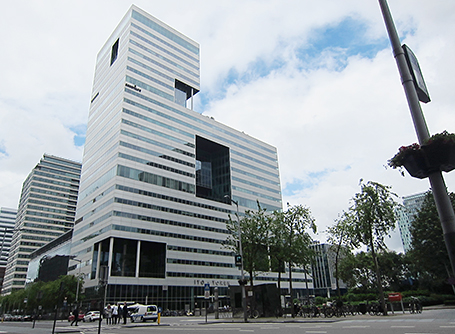
- アムステルダムの開発が進むビジネス街"ズイダス"に建つ《イトウ・タワー》("イトウ・トレン")/Ito Toren in Amsterdam's rapidly developing business district, Zuidas.
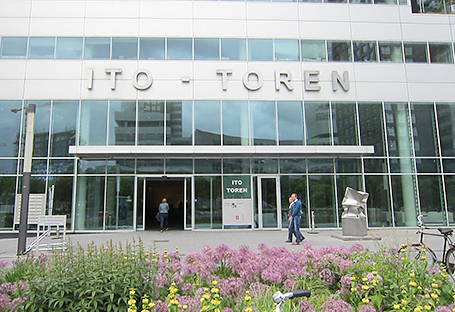
- 《イトウ・タワー》もまた建築家・伊東豊雄に与えられた尊称。/Ito Toren ("Ito Tower" in Dutch) is, yet again, a building named for its Japanese architect, Toyo Ito.
伊東豊雄《アルミニウム・ハウジング》(オランダ、フローニンゲン、2005) 奇しくも《イトウ・タワー》と同じく2005年の竣工であるが、スケールはたいへん小さい。オランダ北部の大学町フローニンゲンにポツリと建つアルミレンガの家プロジェクトである。規模でいうと3階建てで床面積は150㎡しかない。1階にギャラリー・スペースを備える大学のゲストハウスとしてスイスの設計事務所ホソヤ・シェーファー・アーキテクツと協働して伊東豊雄氏が設計したものであり、市当局から直接指名されたものである。敷地は狭い路地に面しており、四方を歴史の重みを感じさせるレンガ造の建物で囲われている(現在、路地に面した入り口は閉じられており、中に入るには建物の裏側にあるユニバーシティ・ホテルから迂回する必要がある。ホテルの受付で頼めば、少なくとも内部の共用スペースは見ることができる)。周囲に比べてこの真新しく見える"ケンチク"のファサードは、ガラスパネル面とその外側にはこのプロジェクトだけのために日本国内で押し出し形成されオランダに送られたアルミ製"レンガ"層のダブルスキン構成となっている。これはオランダの伝統的な石造りの"パターン"を現代的にアレンジしたもので、内部空間に光を通し、かつ内部の居住者に外部と視覚的つながりを与えることで屋内の視覚的な狭さを解消することが目的である。
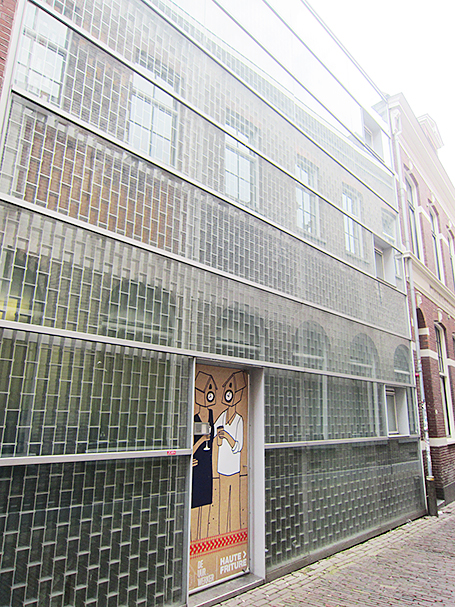
- 伊東豊雄によるフローニンゲンの大学ゲストハウス/University Guest House in Groningen, Holland, by Toyo Ito.
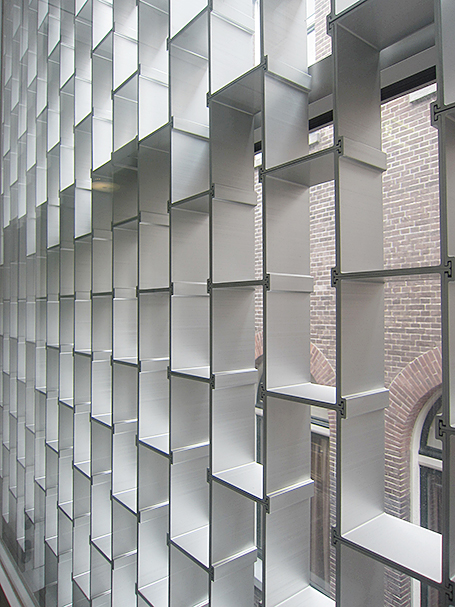
-
オランダの伝統的なレンガ造の街並に応答して、伊東らしいモダンな押し出しアルミニウムで「レンガ」を表現。この「レンガ」は、日本でつくられ船でオランダに運ばれた。/Ito responded to the traditional brick seen all over the Dutch context with his own modern, extruded aluminum "bricks" that were made in Japan and shipped to Holland for a University Guest House in Groningen.
第2の人生を謳歌する《マキ・パヴィリオン》(オランダ、デルフゼイル、1996、2015)
フローニンゲンからさらにドイツ国境近くまで足を伸ばすと、北海に面した小さな港町デルフゼイルに行き着く。槇文彦氏がデザインした《マキ・パヴィリオン》が第2の人生をここで送っている。《マキ・パヴィリオン》はもともとフローニンゲン市が市制誕生750年を記念して1996年に開催されたフェスティヴァル"A Star Is Born."の一環としてデザインされた。コンペを通してオランダ国内および海外のデザイナー(例えばレム・コールハース、ベルナード・チュミ、フランク・ゲーリー、ジャン・ヌーヴェル、ハンス・ホラインなど)が選ばれ、市内15カ所にインスタレーションのデザインが委託された。それらのなかでも《マキ・パヴィリオン》は幅6m全長25mの艀(はしけ)を用いた移動可能なパフォーマンス施設として提案されたものであった。マストのかわりに軽量スティールチューブ製のスパイラルを2重に重ね、その上にセイル・マストを張った形式。スパイラル構造の最上部は高さ9mにもおよぶ(このパヴィリオンはタグボートに曳かれて移動するため、マストが必須であったわけではないが)。全盛期にはパヴィリオンである艀はフローニンゲン内の運河沿いに係留され、寸劇、コンサート、詩の朗読などのイヴェント会場として活躍していた。艀上のサイドレールは倒すと川岸と陸続きにすることができたので、簡単な屋外コンサートホールがどこでも開けた。当時槇氏は「特定の敷地に依存しない」構造体という呼称を用いて、ダイナミックな形態は自ら変形し、かつ自らが登場する場所をも変えると提案している。月日が経った2013年に手紙一通がオランダ一市民から槇氏に届いた。手紙には《マキ・パヴィリオン》が長らく水上にたたずんでいたため、かなり傷んでしまい解体の危機にあるという事態を大変憂慮していことが綴られていた。手紙はさらに続く。「オランダでは法的に、建築物の所有者は当該する建築物をデザインした建築家から保存を要求されると建築物を解体できない。槇氏から保存要求の書面が発行されるべきだ」と結ばれていた。これを受けて槇氏は保存要望の手紙を発行した。一連の流れの背景にはフローニンゲン市当局が維持費用を捻出できずにいた事情があり、結果的に半官半民企業であるNoorderpoortエネルギーおよび港湾会社に払い下げられ全面的に改修が施されたのである。
2015年初頭に改修事業はデルフゼイル近郊で完了した。デルフゼイルはオランダで5番目に大きな港湾を持ち、2番目に大きなセイル・イヴェント"デルフゼイル"の開催地である。

-
槇文彦氏によるオリジナル・ドローイング(1995)。フローニンゲン市のための「特定の敷地に依存しない」移動可能なパフォーマンス施設。(提供=槇総合計画事務所)/Original drawing of Maki-Pavilion (1995), a floating "non-site" performance venue for the City of Groningen. (Drawing used with permission of Maki and Associates).
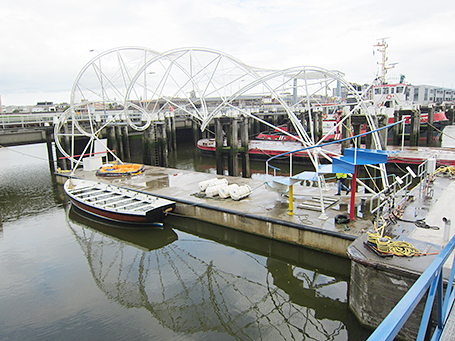
-
長い間水上にあった《マキ・パヴィリオン》が改修され、大学ボート部の船着き場として第2の人生をスタートしている。/After many years sitting in dry dock, Maki-Pavilion has undergone a complete renovation and is starting its new life as the university crew team's boat launch.
《マキ・パヴィリオン》はパフォーマンス会場ではなく、地元学生のセイルボート部の活動拠点として第2の人生を送っている。改修後のパヴィリオンの写真を槇氏に紹介したところたいへん喜んでいただいた。スパイラル状のマストに張られたメッシュ状生地はオリジナルと異なるが、透明性を増してスパイラル状の構造体がより明瞭になったとコメントがあった(次回の"デルフゼイル"は2016年開催で、《マキ・パヴィリオン》を改修後初めて公にお披露目する機会となる。港湾会社はイヴェントの際に会場としてパヴィリオンの活用を検討している)。
旅のまとめ
ため息が出るほど長い旅であったが、気がつくと「あっという間」であった。今回の旅行で7カ国を周遊し、30以上の日本人建築家による"ケンチク"を訪問することができた。それぞれの"ケンチク"はさまざまな背景で異なる期待に応えることが求められたことを強く感じた。いくつかの"ケンチク"は地域や利用者に愛されて、まさに成功しているが、同時にすでに疲弊してしまったり、もしくは閉鎖されてしまった"ケンチク"も目の当たりにした。「ヨーロッパのクライアントが日本から来た建築家を雇う究極の理由は?」と自問をするたびに、おそらく答えはそれほど単純ではないと振り返ってみる。次回、私たちの第5回目である最終寄稿では、私たちなりの分析と、この「究極の理由」に対する答えを見出してみたいと思っている。註
★1──Maurie J. Cohen, Halina Szejnwald Brown, Philip Vergragt eds., Innovations in Sustainable Consumption: New Economics, Socio-Technical Transitions and Social Practices, Edward Elgar Publishing, 2014, p.12.
-
All photos by Nicolai Kruger and Yasuyuki Yanagisawa unless otherwise noted.

The Final Stretch through Austria, Germany & Holland
Terunobu Fujimori: Storkhouse - Raiding, Austria
One of the main reasons to do a driving tour of Europe, is to visit its small towns and villages, which have much to offer. We spent ten days exploring the stunning Austrian scenery, including several days camping in the alpine interior. As in the US and Japan, small European villages and towns are desperate to bolster their economies and maintain their livelihoods, and Austrian towns are no exception. It seems like even the smallest village aggressively promotes its own specialty product; be it cheese, beer or wine; or a novel new, often green, attraction. For example, the village of Krumbach (population 1,000) commissioned seven internationally renowned architects to design seven unique bus-stops. The eastern municipality of Gussing (with 27,000 inhabitants), is now energy independent, running solely on its own woody-biomass plant (tours are available in English). Several towns offer passive-house tours as Austria has the highest per-capita share of low-energy homes in the world.It is within this context that we made time to visit the eastern town of Raiding, best known as the birthplace of 19th century composer Franz Listz, just an hour-drive south of Vienna. Tokyo-based, Austrian writer Roland Hagenburg initiated the Raiding Project to build ten miniature experimental houses, designed by ten Japanese architects with the aim to further cultural exchange between Austria and Japan. Storkhouse, by eco-architect, professor and design-builder Terunobu Fujimori, was the first of these houses to be realized in 2013.
Known for his earthy, whimsical tree-houses, Fujimori's style is quite distinct from his zen-modern Japanese contemporaries. Sometimes compared to Spain's Antoni Gaudí or Vienna's own Hundertwasser, Fujimori's work seems right at home in the Austrian landscape. Storkhouse, clad in deep black, charred boards, with a thick thatched roof, is well protected against rain and rot. In an interview prior to our trip, Fujimori told us that he selected the trees to be used and also actually went and cut them down with members of the community. Nearly the whole town turned out, in fact, everyone curious and smiling. At that point he knew it would be a successful project. We asked if he thought his non-Japanese clients expected anything special from him as an architect from Japan. To this he answered, "no not specifically." On the name, Storkhouse, he told us that he had researched the local flora and fauna and learned that storks migrate from Africa to nest in the region during the summer. Providing a nesting platform on a tower was his way to make the building vernacular and indeed, a family of storks has occupied it every summer. Storkhouse is open to the public for visits and lodging. Raiding Project's next structure, now under construction, is Hara House by Hara Hiroshi.
Tadao Ando: Langen Foundation - Neuss, Germany (near Dusseldorf)
After a few days enjoying vibrant city life of Vienna and Munich we worked our way up the Romantic Road (where the road signs were in German and Japanese!) taking in many castles along the way. Near the central German town of Neuss, we stopped to see the sprawling Museum Insel Hombroich, that occupies a former NATO base. Various architects and artists have created pavilions and installations on the grounds over the years including the Langen Foundation by Tadao Ando. This 1,300 square meter glass and signature concrete exhibition building was initiated to house the extensive modern art collection of Marrianne Langen. Although the building was completed in 2004, the project developer had hired Tadao Ando to study the site as early as 1994.Because we drove directly up to the building, some of the drama of the entry sequence was lost on us, as it seems Ando expected most visitors would be arriving on foot. There is a diagonal path flanked with cherry trees, leading to a reflection pool onto which the main glass exhibition hall projects. Ando would not be happy to see the state of the concrete: moss-covered and water-stained in many places; or to learn that a large glass panel is broken and had been that way for months we were told. Unlike the previous Ando buildings we had seen on our trip, that are enjoying devout stewardship, the Langan Foundation hasn't been very well maintained.
Fumihiko Maki Solitaire - Dusseldorf
Finally we had arrived in the bustling city of Dusseldorf where we would return the VW camping car that we had been calling "home" for nine weeks. According to the Consulate-General of Japan, there are about 11,000 Japanese (including both permanent and temporary residents and German-born citizens of Japanese ancestry) living in Düsseldorf. Since the 1950s the city has hosted over 500 Japanese companies. [Source: Wikipedia] Notably the Japanese super-zenekon Takenaka has had its European headquarters based in Dusseldorf for over 40 years. So it was with great interest that we wandered the streets of the city finding Japanese bookstores, travel agencies, grocery stores and zakka shops. At many restaurants we could find both bratwurst and tonkatsu; sauerkraut and tsukemono on the menu and naturally, both a local hefeweisen and Kirin Ichiban on tap.The Medienhafen development along Düsseldorf's old Rhine River harbor, has rapidly transformed what used to be a derelict warehouse district into a center for the creative industries, advertising, art and media. According the the City of Dusseldorf's homepage, "the transformation did not attempt to force the area into a restrictive architectural corset. On the contrary: the resulting vibrant architectural diversity contributes to the area's unique creative atmosphere..." Nearly all buildings are by well-known, international architects including: Frank O. Gehry, David Chipperfield, Steven Holl, Helmut Jan and a large complex currently under construction by Renzo Piano. These architects were given broad freedoms to create their own unique contributions. Fumihiko Maki's eight-story Maki-Solitaire was one of the first buildings to be realized at Medienhafen in 2001. It was a direct commission for a private client who had been impressed with Maki's office at Hillside Terrace in Tokyo. Maki-Solitaire is carefully crafted with aluiminum cladding and horizonal louvers, through which he may have tried to set the initial, elegant tone for the whole development. Unfortunely, Maki-Solitarire's thoughtful composition is now all but lost in the incongruous melange of big ideas competing for attention.
Ito Toren - Amsterdam
Saying goodbye to our camping car was a mixed blessing, as we were relegated to public transportation in order to reach our final destination: Amsterdam. It seemed a lot easier in theory than in practice as we had two suitcases, four large bags, two children and a stroller... somehow, we made it onto the high-speed train to Amsterdam Central Station and into our apartment in the uber-cool Pijp neighborhood for the final week of our journey. We were so happy to be staying right in the city and able to walk everywhere. The beauty and richness of the canals, sidewalk cafés, bike-filled streets old and brick facades, was almost too much for us to absorb.Amsterdam is also developing a new business district called Zuidas (meaning south-axis in Dutch). Likening itself to La Defense in Paris or Canary Wharf in London, Zuidas is attracting major multi-national and creative firms to locate there. In a similar fashion to Dusseldorf's Medienhafen, all new buildings in Zuidas, whether post-modern, high-tech or "super-Dutch," are designed by world-renowned architects including: Rafael Vinoly, Norman Foster, Michael Graves and SOM.
Completed in 2005, the 26-story high-rise tower called "Ito Toren" was designed by -- you guessed it - Toyo Ito. "Japanese elegance" is how Ito Toren is described in a brochure about the project. With a play of transparency, solid and void, the glass surfaces are perfectly in-plane with the snow-white aluminum panels. The overall massing is stepped, with a sharp, angular expression. There are large voids penetrating deep into the building's volume ensuring that daylight can reach all its occupants. At 100 meters tall, with 26 floors and 40,000 square meters of floor area, Ito Toren is surprisingly large-scale.
Toyo Ito: Aluminum Brick Housing
Also completed in 2005 but at a vastly different scale, Ito's Aluminum Brick Housing project in the northern Dutch city of Groningen. It is only three stories tall with only 150 square meters of floor area. It is actually a university guest-house with gallery space on the ground floor for which Ito, in collaboration with the Swiss firm Hosoya Schaefer Architects, was commissioned directly by the city. The site is located on a narrow alley, with historic brick buildings on all sides. The new building facade is a glass curtain-wall behind extruded aluminum "bricks" that were fabricated in Japan and shipped to Holland specifically for the project. It is a new take on traditional Dutch masonry unit, providing light, transparency and an expansive view onto the narrow street for the building's occupants.Maki Pavilion
Just a short train ride north of Groningen is the town of Delfzijl on the North Sea and the port where Maki-Pavilion, by Fumihiko Maki, is currently located. It was originally designed for the City of Groningen's 1996 festival entitled, "A Star Is Born." The city commissioned 15 temporary site installations by Dutch and international architects and artists (including: Rem Koolhaus, Bernard Tschumi, Frank O. Gehry, Jean Nouvel and Hans Hollein) to be located all around the city. Maki-Pavilion was conceived as a mobile performance venue situated on a 6 meter wide by 25 meter long, flat-bottom barge. Instead of a mast there is a lightweight double twisting spiral superstructure 9 meters high at its highest that is stretched with white sail canvas (there was never a need for actual sails because the pavilion is moved by tugboat). In its heyday, the barge played host to skits, concerts and poetry readings and could be positioned on either bank all along the river or canals of Groningen. Side railings could fold down onto the dry land allowing it to become a sort of open-air concert shell. Maki uses the term "non-site" structures referring to how dynamic forms change themselves and also change the place they happen to occupy.In 2013, a concerned Dutch citizen sent a letter to Maki informing him that due to its many years sitting in the water, Maki-Pavilion had started to fall into disrepair and risked being demolished. The letter went on to explain that under Dutch law, the owner of building couldn't demolish it if the architect formally requests that the structure be preserved. The letter urged Mr. Maki to issue such a request, which Maki's office did. Because the City of Groningen wasn't able to pay for its upkeep, Noorderpoort Energy & Maritime, a semi-public company, purchased the dilapidated Maki-Pavilion for next to nothing and then endeavored to fully restore it. Earlier this year the work was complete in the nearby town of Delfzijl, the fifth biggest seaport and the home of "Delfsail," the second-largest sailing event of the Netherlands. Fittingly, Maki-Pavilion is no longer a performance venue but now serves as a boat launch for the local crew team. We shared pictures of the newly renovated pavilion with Maki-sensei at his office, and he seemed pleased. He noted how the new mesh-like fabric being almost transparent made the spiral structure more clear, indeed.
Conclusion
It has been a long journey but, at times, a seemingly short trip. We managed to visit seven European countries and see over thirty buildings designed by Japanese architects. They had to address numerous expectations in various contexts. We saw some of the projects as successful (loved by their communities and users) while others are already wearing out, even closed. When we ask ourselves: "What is the ultimate reason that European clients hire architects from Japan?" we have to say: the answer is not that simple. Our fifth and final article will be devoted to our analysis and attempt to answer this question.NOTE
★1──Maurie J. Cohen, Halina Szejnwald Brown, Philip Vergragt eds., Innovations in Sustainable Consumption: New Economics, Socio-Technical Transitions and Social Practices, Edward Elgar Publishing, 2014, p.12.
All photos by Nicolai Kruger and Yasuyuki Yanagisawa unless otherwise noted.
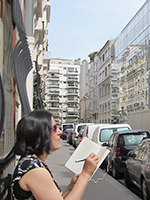
- Nicolai Kruger
ニコライ・クルーガー
2006年より東京に在住し、ペリ・クラーク・ペリ・アーキテクツ・ジャパンにて設計実務に携わる。在籍中にアジア各地で様々な規模の商業施設、文化施設プロジェクトデザインを担当。現在ヨーロッパ各国の日本人建築家の作品を調査するためヨーロッパ周遊中。コーニッシュ・カレッジ・オブ・アート(シアトル市、ファインアーツ学位)卒業後オレゴン大学大学院にて建築意匠学修士号取得。
Nicolai Kruger, AIA
Nicolai Kruger is an American architect who has been based in Tokyo since 2006 practicing with the firm Pelli Clarke Pelli Architects, Japan. She has worked on large-scale commercial and cultural projects throughout Asia. She has been writing in-depth reviews of architecture, art and design exhibitions bi-monthly for the on-line magazine DNP Artscape Japan. Currently she is on-assignment researching the work of Japanese architects in Europe. Nicolai has a BFA in Design from Cornish College of the Arts in Seattle, and a Masters of Architecture from the University of Oregon.
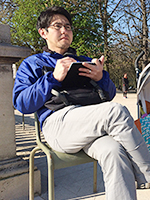
- Yasuyuki Yanagisawa
柳澤恭行(やなぎさわ・やすゆき)
1973年、新潟県生まれ。2004年オレゴン大学大学院修了(建築学専攻)。アメリカ登録建築家。アメリカ、日本国内組織設計事務所勤務。主にホスピタリティ系施設デザインやコミュニティ主体の街づくり計画に取り組む。明治大学、工学院大学にて非常勤講師(2009-14)、およびオレゴン大学京都夏季セミナーで講師、講評を担当。現在YK Design Consultantsプリンシパルとしてオレゴン州ポートランドと東京を基点に活動中。
Yasuyuki Yanagisawa, AIA
Yasuyuki Yanagisawa was born in Niigata, Japan in 1973. After receiving his Masters of Architecture from the University of Oregon in 2004, he practiced in both the US and Japan for medium and large-scale firms. He has a special interest in hospitality design as well as community-oriented urban development. Yasuyuki has taught design studios and seminars at Meiji and Kogakuin Universities, he is also a regular lecturer and critic for the University of Oregon, Summer Kyoto Program. He, as a principal of YK Design Consultant, is consulting internationally with bases in both Tokyo and Portland, Oregon.


